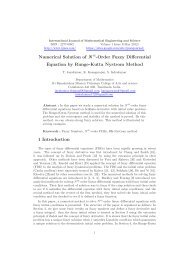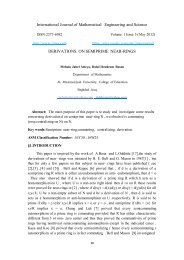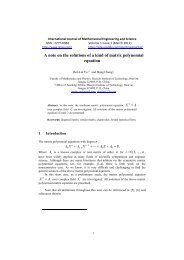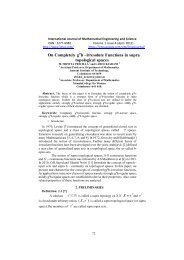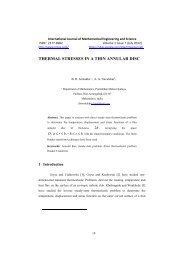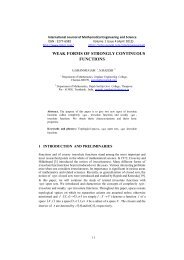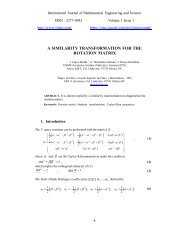International Journal of Mathematical Engineering and ... - ijmes
International Journal of Mathematical Engineering and ... - ijmes
International Journal of Mathematical Engineering and ... - ijmes
Create successful ePaper yourself
Turn your PDF publications into a flip-book with our unique Google optimized e-Paper software.
<strong>International</strong> <strong>Journal</strong> <strong>of</strong> <strong>Mathematical</strong> <strong>Engineering</strong> <strong>and</strong> Science<br />
ISSN:2277-6982 Volume 1 Issue 5 (May 2012)<br />
http://www.<strong>ijmes</strong>.com<br />
https://sites.google.com/site/<strong>ijmes</strong>journal/<br />
A NOTE ON TRIGONOMETRIC FUNCTIONS AND<br />
INTEGRATION<br />
Mehsin Jabel Atteya, Dalal Ibraheem Rasen<br />
Department <strong>of</strong> Mathematics<br />
Al- Mustansiriyah University, College <strong>of</strong> Education<br />
Baghdad ,Iraq.<br />
mehsinatteya@yahoo.com,<br />
dalalresan@yahoo.com<br />
Abstract: The main purpose <strong>of</strong> this paper is to use the idea <strong>of</strong> finding the unlimited<br />
integration <strong>of</strong> the product <strong>of</strong> powers <strong>of</strong> the (sinz) <strong>and</strong> (cosz)-functions, <strong>and</strong> the product <strong>of</strong><br />
powers <strong>of</strong> the (tanz) <strong>and</strong> (secz)-functions to derive tow trigonometrically identities.<br />
Key words: Complex functions, integration, complex trigonometric functions.<br />
ASM Classification Number: Primary 26D05.<br />
§1.INTRODUCTION<br />
This paper is inspired <strong>and</strong> motivation by the work <strong>of</strong> [1].The theory <strong>of</strong> functions <strong>of</strong><br />
complex variable , also called for brevity complex variables or complex analysis , is one <strong>of</strong><br />
the most beautiful as well as useful branches <strong>of</strong> mathematics. Although originating in an<br />
atmosphere <strong>of</strong> mystery, suspicion <strong>and</strong> distrust ,as evidenced by the terms "imaginary" <strong>and</strong><br />
"complex" present in the literature, it was finally placed on a sound foundation in the 19 th<br />
century through the efforts <strong>of</strong> Cauchy, Riemann, Weierstrass, Gauss <strong>and</strong> other great<br />
mathematicians. Today the subject is recognized as an essential part <strong>of</strong> the mathematical<br />
background <strong>of</strong> engineers, Physicists, mathematicians <strong>and</strong> other scientists. From the<br />
theoretical view –point this is because many mathematical concepts become clarified <strong>and</strong><br />
unified when examined in the light <strong>of</strong> complex variable theory. From the applied viewpoint<br />
the theory is <strong>of</strong> tremendous value in the solution <strong>of</strong> problems <strong>of</strong> heat flow, potential theory ,<br />
fluid mechanics, electromagnetic theory, aerodynamics, elasticity <strong>and</strong> many other field <strong>of</strong><br />
science <strong>and</strong> engineering. Many authors doing in complex variables <strong>and</strong> gave some results<br />
about that [see (2),(3),(4)]. A. D. Sinder [5] proved that , if the complex –valued function f(t)<br />
is continuous on [a,b] <strong>and</strong> F′(t)=f(t) for all t in [a,b],then<br />
30
<strong>International</strong> <strong>Journal</strong> <strong>of</strong> <strong>Mathematical</strong> <strong>Engineering</strong> <strong>and</strong> Science<br />
ISSN:2277-6982 Volume 1 Issue 5 (May 2012)<br />
http://www.<strong>ijmes</strong>.com<br />
https://sites.google.com/site/<strong>ijmes</strong>journal/<br />
Murray R.Spiege [6]proved that, the integration <strong>of</strong> F(z)G(z)<br />
is equal to F(z)G(z)-<br />
Where F(z) <strong>and</strong> G(z) are complex variable functions . Ruel V. Churchill , James W. Brown<br />
<strong>and</strong> Roger F. Verhey [7] proved that<br />
Whenever the path <strong>of</strong> integrations is a contour.<br />
From our we know study the integration <strong>of</strong> the trigonometric function (sinz cosz dz).<br />
The solution <strong>of</strong> above integration we can find by substituting y=sin z to obtain that.<br />
+c 1<br />
If we use the substituting y=cos z , we obtain +c 2<br />
It is clear from that the difference between these tow answers is constant number this implies<br />
to .<br />
sin z+cos z=c ,<br />
where c is constant number <strong>and</strong> by substituting z=0 in the above equation we get.<br />
sin z+cos z=1.<br />
In our paper we shall is to use the idea <strong>of</strong> finding the unlimited integration <strong>of</strong> the product <strong>of</strong><br />
powers <strong>of</strong> the (sin z) <strong>and</strong> (cos z)-functions, <strong>and</strong> the product <strong>of</strong> powers <strong>of</strong> the (tan z) <strong>and</strong> (sec<br />
z)-functions.<br />
§2.THE MAIN RESULTS:<br />
Theorem 2.1:For all complex values <strong>of</strong> z , the following<br />
=<br />
Will be true where n,m are positive integers.<br />
31
<strong>International</strong> <strong>Journal</strong> <strong>of</strong> <strong>Mathematical</strong> <strong>Engineering</strong> <strong>and</strong> Science<br />
ISSN:2277-6982 Volume 1 Issue 5 (May 2012)<br />
http://www.<strong>ijmes</strong>.com<br />
https://sites.google.com/site/<strong>ijmes</strong>journal/<br />
Pro<strong>of</strong>: We consider the following integration<br />
z cos<br />
z dz<br />
By writing this integration by the following<br />
z cos<br />
z cosz dz<br />
= z (1-sin<br />
By using the substituting y=sin z, we get<br />
And by using Binomial formula we get<br />
y<br />
dy<br />
= dy<br />
= dy<br />
= +c 1<br />
= c 1<br />
By same method we can find z cos z dz<br />
By writing this integration by the following<br />
cos<br />
z sin z dz<br />
Using the substituting y=cos z, for obtain<br />
32
<strong>International</strong> <strong>Journal</strong> <strong>of</strong> <strong>Mathematical</strong> <strong>Engineering</strong> <strong>and</strong> Science<br />
ISSN:2277-6982 Volume 1 Issue 5 (May 2012)<br />
http://www.<strong>ijmes</strong>.com<br />
https://sites.google.com/site/<strong>ijmes</strong>journal/<br />
And by using Binomial formula we get<br />
- y dy<br />
= dy<br />
= dy<br />
= +c 2<br />
= c 2<br />
But the difference between tow answers is constant number, this implies to<br />
+ =c(n,m)<br />
And by choose z=0 ,we get<br />
C(n, m)=<br />
We assume that x=m+1,which implies<br />
=<br />
Thus c(n, m)=<br />
By same method in the pro<strong>of</strong> <strong>of</strong> Theorem(2.1)we can prove the following theorem<br />
Theorem2.2: For all complex values <strong>of</strong> z , the following<br />
33
<strong>International</strong> <strong>Journal</strong> <strong>of</strong> <strong>Mathematical</strong> <strong>Engineering</strong> <strong>and</strong> Science<br />
ISSN:2277-6982 Volume 1 Issue 5 (May 2012)<br />
http://www.<strong>ijmes</strong>.com<br />
https://sites.google.com/site/<strong>ijmes</strong>journal/<br />
, will be true where n, m are positive integers<br />
Pro<strong>of</strong>: We consider the following integration<br />
We take y=tan z <strong>and</strong> y=sec z, so it easy to complete our prove by same method in<br />
Theorem(2.1).<br />
We closed our paper by the following corollaries after depended on some fundamental<br />
relations <strong>of</strong> exponential <strong>and</strong> trigonometric functions.<br />
Corollary 2.3: For all complex values <strong>of</strong> z, the following<br />
=<br />
Will be true where n, m are positive integers<br />
Corollary 2.4: For all complex values <strong>of</strong> z, the following<br />
=<br />
Will be true where n , m are positive integers<br />
Acknowledgments. The authors would like to thank the referee for her/his useful comments<br />
.<br />
<strong>International</strong> <strong>Journal</strong> <strong>of</strong> <strong>Mathematical</strong> <strong>Engineering</strong> <strong>and</strong> Science<br />
34
ISSN:2277-6982 Volume 1 Issue 5 (May 2012)<br />
http://www.<strong>ijmes</strong>.com<br />
https://sites.google.com/site/<strong>ijmes</strong>journal/<br />
REFERENCES:<br />
[1] I. Dubait , Integration <strong>and</strong> Trigonometry , Dirasat , Pure Sciences , Vol .4 (1997), No .1,<br />
665-666.<br />
[2] Olariu , Silviu(2002) , Complex Numbers in N Dimensions, Hyperbolic Complex<br />
Numbers in Two Dimensions, North-Holl<strong>and</strong> Mathematics Studies #190, Elsevier ISBN 0-<br />
444-51123-7, ,Pages 1-16.<br />
[3] Hazewinkle , M., Double <strong>and</strong> dual numbers, Encyclopedia <strong>of</strong> Mathematics<br />
Soviet/AMS/Kluwer,Dordrect,(1994).<br />
[4] Irene Sabadini (2009), Michael Shapiro & Frank Sommen , editors , Hypercomplex<br />
Analysis <strong>and</strong> Applications Birkhauser ISBN 9783764398927.<br />
[5]A.D.Sinder(1976) , Fundamentals <strong>of</strong> complex analysis for mathematics Science <strong>and</strong><br />
<strong>Engineering</strong>, Prentice-Hall, Inc. Englewood Cliffs, New Jersey.<br />
[6] Murray R. Spiegel(1972) ,Theory <strong>and</strong> Problems <strong>of</strong> Complex Variables, Schaum′s<br />
Outline Series, McGraw-Hill Book Company.<br />
[7] Ruel V.Churchill, James W.Brown <strong>and</strong> Roger F. Verhey(1974), Complex Variables <strong>and</strong><br />
applications, 3th Edition. <strong>International</strong> Student Edition ,McGraw-Hill Kogakusha,LTD.<br />
.<br />
35



